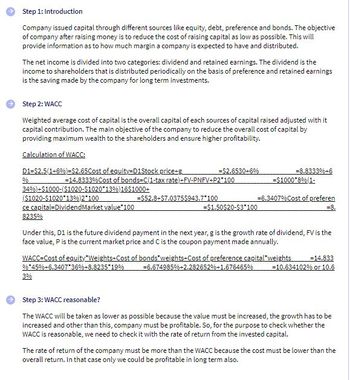The capital structure for Magellan Corporation is shown below. Currently, flotation costs are 13% of market value for a new bond issue and $3 per share for preferred stock. The dividends for common stock were $2.50 last year and have an estimated annual growth rate of 6%. Market prices are $1,020 for bonds, $20 for preferred stock, and $30 for common stock. Assume a 34% tax rate. Financing Type % of Future Financing Bonds (8%, $1k par, 16 year maturity) 36% Common equity 45% Preferred stock (5k shares outstanding, $50 par, $1.50 dividend) 19% Total % 100% Compute the company’s WACC. Is this WACC considered reasonable given the assumptions and other relevant information? Explain.
Cost of Capital
Shareholders and investors who invest into the capital of the firm desire to have a suitable return on their investment funding. The cost of capital reflects what shareholders expect. It is a discount rate for converting expected cash flow into present cash flow.
Capital Structure
Capital structure is the combination of debt and equity employed by an organization in order to take care of its operations. It is an important concept in corporate finance and is expressed in the form of a debt-equity ratio.
Weighted Average Cost of Capital
The Weighted Average Cost of Capital is a tool used for calculating the cost of capital for a firm wherein proportional weightage is assigned to each category of capital. It can also be defined as the average amount that a firm needs to pay its stakeholders and for its security to finance the assets. The most commonly used sources of capital include common stocks, bonds, long-term debts, etc. The increase in weighted average cost of capital is an indicator of a decrease in the valuation of a firm and an increase in its risk.
The capital structure for Magellan Corporation is shown below. Currently, flotation costs are 13% of market value for a new bond issue and $3 per share for
|
Financing Type |
% of Future Financing |
|
Bonds (8%, $1k par, 16 year maturity) |
36% |
|
Common equity |
45% |
|
Preferred stock (5k shares outstanding, $50 par, $1.50 dividend) |
19% |
|
Total % |
100% |
Compute the company’s WACC. Is this WACC considered reasonable given the assumptions and other relevant information? Explain.
Trending now
This is a popular solution!
Step by step
Solved in 3 steps

The calculations in step 2 is very hard to read. Can it be written more clearly, please?









